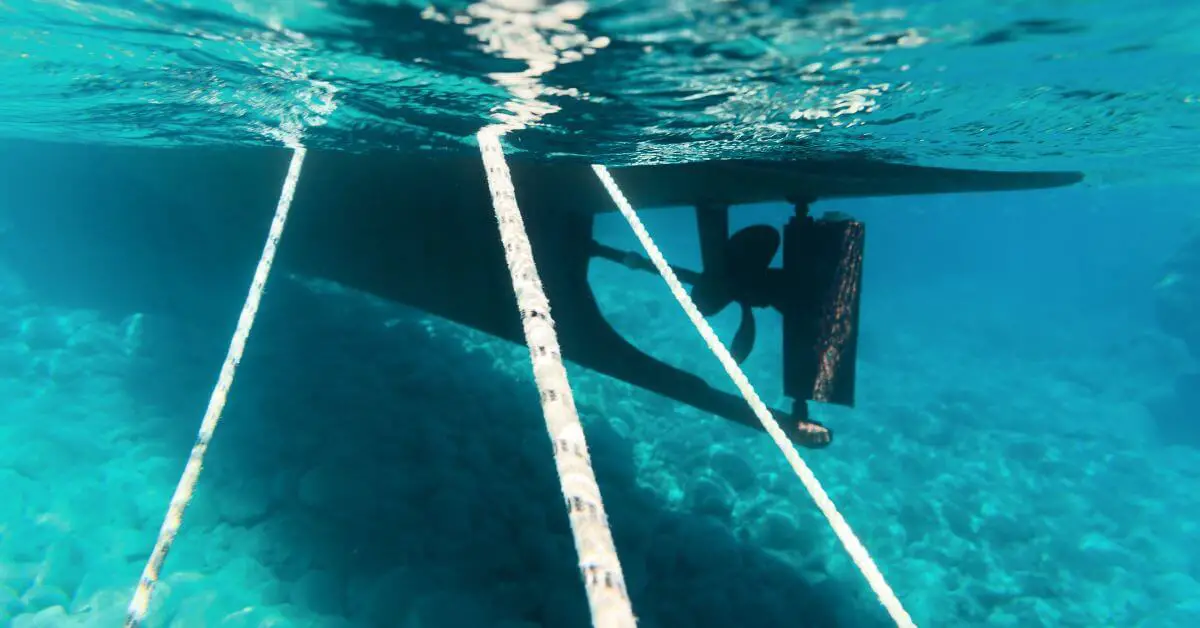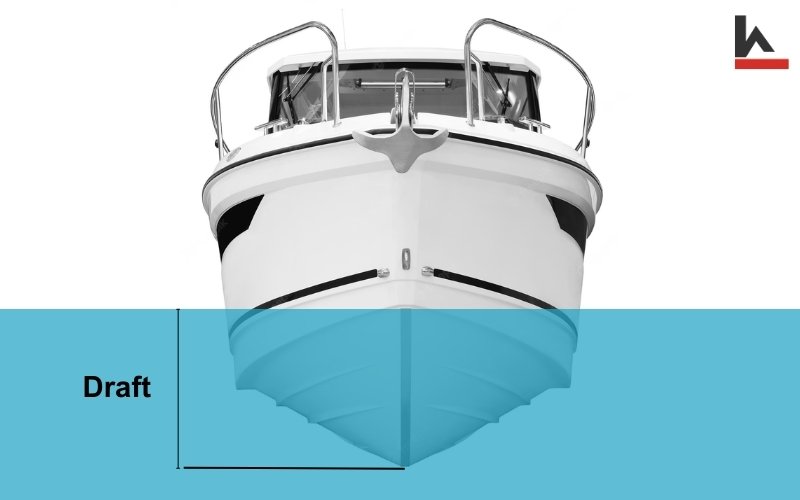Navigating the open waterways requires a comprehensive understanding of various factors, one of which is the concept of boat draft. Whether leisurely cruising in tranquil inland waterways or bracing yourself against the unrelenting choppy tides, a boat’s draft critically impacts a vessel’s maneuverability and safety.
In this article, we will expound on the concept of boat draft – its definition, significance, and how it directly impacts the overall performance of a waterborne vessel.
What is Boat Draft? | The Definition of the Draft of a Boat
Defining boat draft is straightforward. It denotes the shortest distance from the water’s surface to the lowest extremity of a vessel’s hull, generally the keel. Essentially, it represents the vertical depth a vessel submerges underwater, and you measure it from the waterline.
It’s important to note, however, that what constitutes the ‘deepest part’ of the boat may vary depending on the type of vessel. Inboard propulsion boats usually measure the draft from the rudder or propeller since these parts sit deepest in the water. Contrastingly, sterndrive or outboard boats measure the draft from the drive when it’s lowered into the water.
Understanding the draft of your boat imbues you with the confidence to steer through potentially precarious areas, thus preventing mishaps leading to potentially expensive repairs. However, understanding boat drafts isn’t just about dodging underwater obstacles.
Typically measured vertically and stated in units of feet, several factors determine a boat’s draft. These factors include the boat’s weight distribution, the hull’s design, and even the type of boat itself. By understanding these factors thoroughly, you can ensure you are always sailing safely and efficiently.
Boat Draft Measurement | How to Calculate the draft on a Boat
Knowing your boat’s draft measurement is crucial for smooth and safe sailing. The draft refers to the vertical distance from the waterline to the boat’s lowest point, including the keel, propeller, or outboard engine. Understanding how to accurately and effectively measure your boat’s draft is essential for an optimal boating experience.
Here are a few methods you can use to calculate the draft of a boat:
Method 1: Refer to Manufacturer Specifications
One of the simplest ways to determine your boat’s draft is by checking the manufacturer’s specifications in your vessel’s manual or on the manufacturer’s website. Boat manufacturers usually provide draft measurements for their models. However, remember that the listed draft is based on a standard model and can vary depending on your specific boat’s configuration, equipment, or load.
Method 2: Measure at the Waterline
A more hands-on approach involves measuring the draft when the boat is on the water. Mooring your boat in calm waters is essential for accurate measurements. With the help of a measuring tape, first, establish the location of the boat’s waterline. Then, moving from the bow to the stern, take vertical measurements from the waterline to the deepest part of the hull. Do not forget to consider parts like the rudder or propeller that may affect the draft measurement.
Method 3: Dry Dock Measurements
Another method of measuring your boat’s draft is by taking measurements while the boat is on dry land or in a boatyard. Using a measuring tape, identify the lowest part of the boat’s hull and take vertical measurements from the keel to the waterline marking on your boat. This method allows for a more stable and controlled measurement environment but would require a clear and visible waterline marking on your boat.
Method 4: Calculating Draft Measurement
For those preferring a mathematical approach, you can calculate your vessel’s draft by determining its displacement. You’ll need your boat’s length overall (LOA), beam, and a constant factor related to its hull shape.
Boat manufacturers typically provide these values, or you can measure them yourself. Multiply LOA by the beam and constant factor, and divide the result by the product of 1025 (the average density of saltwater) and 35 (conversion factor for cubic feet to long tons). This calculation can offer an approximation of your boat’s draft.
Boat Draft (in feet) = (LOA × Beam × Constant Factor) / (1025 × 35)
Remember, these techniques may provide different results, and the calculations may give just an approximate figure. So, it’s best to cross-check and be mindful of your boat’s specific factors while measuring its draft.
Key Factors Affecting Boat Draft
Several aspects are pivotal in affecting a boat’s draft, which one must carefully consider. These include the hull’s design and shape, the existence or nonexistence of a keel, the boat’s size and weight, water depth and conditions, and the kind of water body where the boat will be navigated.
To explain the significance of these elements, consider the following key points:
1.Hull Design: The hull’s design and form significantly influence a boat’s draft. A boat with a deep-V hull usually exhibits a deeper draft than a flat-bottomed hull counterpart. This hull design impacts the boat’s stability, maneuverability, and adaptability to diverse water conditions.
2. Presence or Absence of a Keel: The keel’s existence is paramount in determining the boat’s stability and draft. Keel-equipped boats have a deeper draft and enhance stability, particularly in choppier waters. Conversely, boats that lack a keel have a shallow draft but may compromise on stability.
3. Size and Weight: The boat’s size and weight directly affect its draft. Generally, larger and heavier boats have a deeper draft than smaller and lighter vessels. The quantity of gear, passengers, and fuel onboard also plays a role in influencing the boat’s draft.
Importance of Understanding Boat Drafts
Promoting Safety on the Water
Being well-versed in your boat’s draft significantly enhances navigation in shallow waters. Shallow conditions pose the risk of running aground, leading to hull damage or even accidents. With a clear understanding of your boat’s draft, you can confidently avoid hazards and navigate towards safer waters.
Selecting Suitable Mooring Options
Different depths demand specific mooring techniques. Knowing your boat’s draft allows you to pick the most appropriate mooring method, catering to distinct water depth conditions. Your knowledge also lets you plan your routes wisely, steering clear of areas with insufficient depth and not getting delayed by bottlenecks or obstructions.
Optimize Your Boat’s Performance
Your boat’s draft impacts its maneuverability, fuel efficiency, and overall handling. By being mindful of the draft, you can make informed decisions regarding the speed and direction to optimize performance. Excessive drafts might lower a boat’s performance, create drag, and decrease the top speed. Conversely, insufficient drafts can compromise stability and make the boat prone to capsizing.
This knowledge empowers you to confidently navigate an array of water conditions, ensuring a smooth and enjoyable experience on the water.
Assessing Load Carrying Capacity
Every boat possesses a maximum weight capacity that it can safely accommodate. Familiarity with a boat’s draft helps you manage the distribution of the load accordingly. Overloading a boat beyond its draft capacity could result in unstable and dangerous conditions, posing a threat to everyone on board.
The added weight subsequently submerges the boat deeper into the water, increasing the draft. Boaters must remain aware of their boat’s recommended load carrying capacity, as this factor directly impacts the draft.
Shallow Waters and Drafts
Shallow waters, with their lesser depth compared to deeper seas, can present various challenges for boat navigation. While the precise measurement for ‘shallow’ varies, these aquatic zones generally symbolize areas unsuitable for certain boats due to insufficient water depth. For vessels with a deeper draft, navigating these shallows can pose difficulties, potentially leading to grounding.
Hazards in shallow waters include submerged objects like rocks, sandbanks, and coral reefs that can significantly damage a boat’s hull or propellers. Moreover, the water may be prone to choppy conditions, proliferating navigation difficulty and accident risk.
What is a Shallow Draft Boat?
In the boating realm, shallow draft boats are designed to navigate shallow waters confidently. Unlike their deeper-draft counterparts, these boats boast a hull design that facilitates operation in minimal water depth environments. They are prized assets for boaters frequenting shallow courses such as rivers, lakes, and coastal inlets.
Owning a boat with a shallow draft presents a multitude of benefits. Foremost, these boats provide access to areas otherwise unreachable, encouraging exploration of hidden creeks, marshlands, and backwaters.
They also cater to anglers, able to weave through shallow flats where larger boats hesitate to navigate. Furthermore, their capacity to traverse shallow waters enhances fuel efficiency compared to vessels with a deeper draft.
What is a Deep Draft Vessel?
Unlike shallow draft vessels, deep draft boats require generous water depth to float safely and maneuver adeptly. They are not designed for shallower waterways, which sets them apart from their shallow-draft counterparts.
One clear advantage of a deep-draft design is its heightened stability in choppy waters. With a lower center of gravity and a hull that penetrates deeper into the water, such boats perform better under tough conditions and large waves, making them suitable for extensive journeys and offshore escapades.
However, the disadvantages are also evident. Because of their need for deep water, they are restricted from navigating shallower domains, such as rivers, lakes, and coastal regions, limiting the range of possible exploration sites.
They also consume more fuel than shallow-draft boats, with their voluminous hulls and increased weight demanding more power to move through the water. Thus, a deep draft boat may not be optimal if access to shallow backcountry waters is required.
Conclusion
Understanding the concept of boat draft is essential for anyone involved in water transportation. Boat draft affects the vessel’s safety, efficiency, and functionality, as well as the navigability of waterways.
Knowledge of a boat’s draft, influenced by factors such as hull shape, weight distribution, cargo load, water depth, and tides, allows operators to stay within legal limits, minimizing potential accidents, ensuring the well-being of crew and passengers, and protecting the environment.









